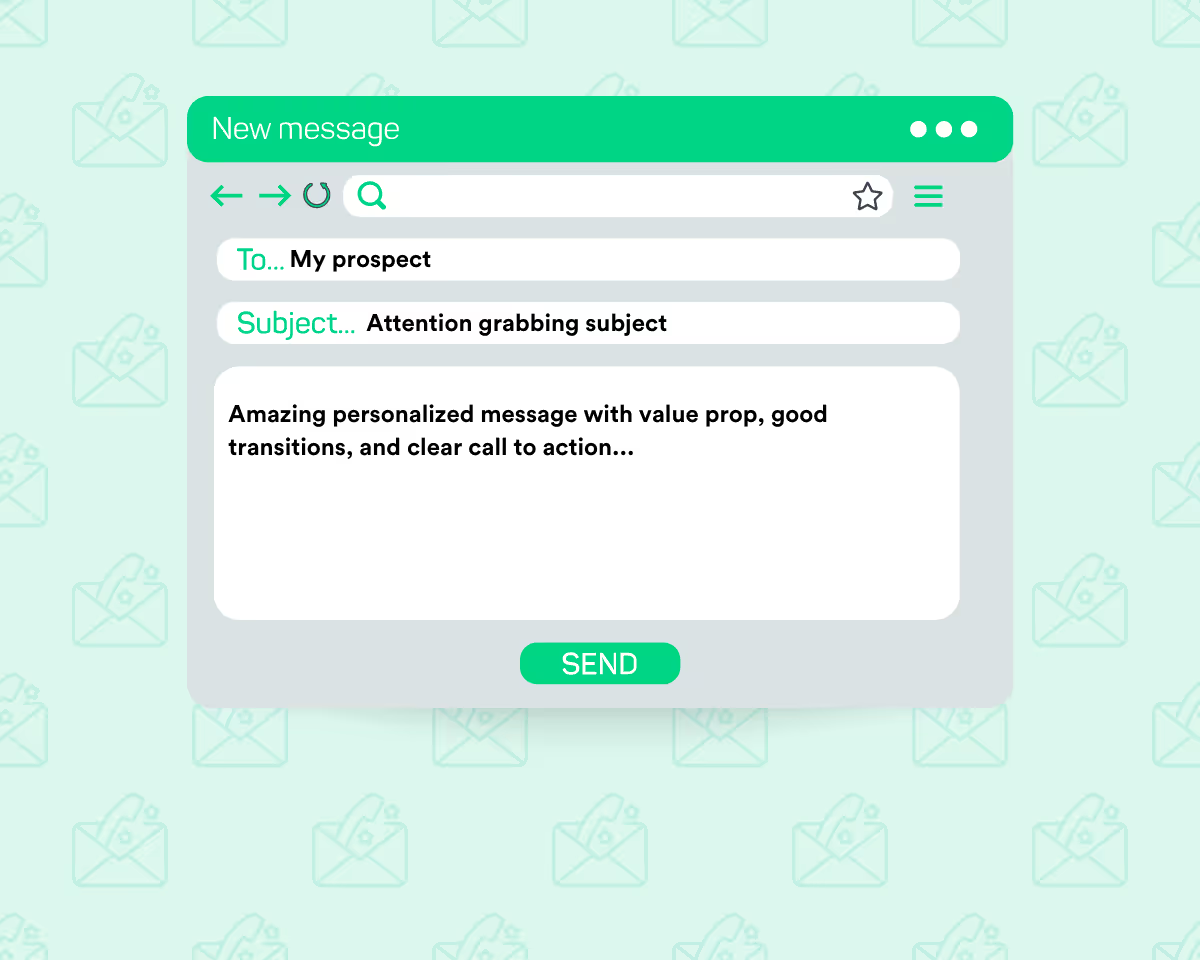Ready to create more pipeline?
Get a demo and discover why thousands of SDR and Sales teams trust LeadIQ to help them build pipeline confidently.





Get a demo and discover why thousands of SDR and Sales teams trust LeadIQ to help them build pipeline confidently.
In the world of B2B SaaS sales, outbound email sequences play a critical role when it comes to building meaningful connections with potential customers and closing more deals. Whether you’re reaching out to prospects, leads, or clients, the art of crafting effective outbound messages is an essential skill you need to possess.
When it comes to creating outbound email sequences, the best outreach sequences utilize storytelling techniques to engage and ultimately convert prospects. In the buyer’s journey, the seller is never the hero. Instead, they’re the trusted guide who walks the prospect down the path, educating them, adding value, and helping them make a decision that suits their needs the best.
For this reason, the best outbound sales sequences for SaaS companies are highly organized and logical. Rather than confusing the recipient and leaving them frustrated and unsure of what to do next, the best sales sequences are intuitive, logical, and easy to understand, focusing on the customer as the hero of the story.
Since every good story also needs a villain, effective B2B email sequences also highlight the internal and external conflicts the hero is facing. Whatever pains your prospects are dealing with — and however those pains are impacting them — need to be addressed head-on.
While storytelling is a vital part of a successful B2B outbound sequence, it’s not the only element that the best campaigns have in common. Keep reading to learn more about creating effective sequences, including how to write subject lines that engage readers, best practices for structuring sequences, how to tailor messages to different personas, and the important role personalization plays in impactful campaigns.
According to a recent QuickMail report, the average open rate for cold emails is 44%. So, right off the bat, more than half of the folks on the receiving end of your sales sequence emails won’t engage with your messages if you’re using run-of-the-mill tactics.
However, that same QuickMail report found that 8% of cold email campaigns are opened at least 80% of the time. Which begs the question: How are those top performers bucking the trend?
It starts with writing compelling subject lines that grab the prospect’s attention and encourage them to open the message in the first place. Since the average business user receives 121 emails every day — and the subject line is the first thing the recipient sees when a message arrives in their inbox — ensuring each message in your sequence has an eye-catching subject line is critical to success.
First and foremost, make sure your subject lines are clear and concise. Generally speaking, aim for a subject line that’s no longer than nine words containing somewhere around 50 to 60 characters. You should also consider your audience; ideally, the recipient will have an idea of what the message is about after reading the subject line. By making the benefit of opening each message obvious from the outset, you can help prospects make a decision about whether to engage with your email faster — exactly what a trusted guide would do.
Since personalization plays a critical role in successful B2B email sequences (more on this in a bit), consider sprinkling your prospect’s first names into subject lines intermittently. For example, if you’re selling a sales prospecting solution to someone you know is using an outdated platform, you might include this subject line in your sequence: Susan, are you frustrated with your sales prospecting tool?
However, it’s important to strike a balance here. Greeting the prospect by their first name will help you personalize the experience. But if you use their name too frequently, it could come across as aggressive and spammy. As a general rule, consider using the prospect’s name during your initial outreach and a few follow-up emails. As you move through the sequence, you shouldn’t include their name in every single subject line; that’s overkill.
Additionally, subject lines should be crafted in a way that sparks curiosity and makes your messages stand out. By teasing or hinting at the content of your messages, you can pique the reader’s interest and create a sense of intrigue, which encourages them to engage with the email. When it comes to promotional offers, being more direct and to the point — think: 50% off if you act now! — can work wonders, too.
Don’t forget about emojis, either. While some say that including emojis in subject lines can increase click-through rates, others have found that using emojis in subject lines can have a disastrous impact on engagement. Consider testing emojis to see what your ideal customer profile responds best to. If an emoji can help you increase the clarity of your message or has a direct tie to the subject line you’re using, it may be worth adding one in. Using them for show or decoration, however, is generally ineffective in our experience.
Whatever you do, make sure to experiment with subject lines by performing A/B testing on each message in your sequence. For example, you might send one subject line out to 20% of your list and another out to a different 20% of your list, waiting three hours to see which version is best received by your audience. Using email marketing or sales engagement tools, you can automatically send the remaining 60% of your prospects the version with the more effective subject line, which should increase open rates across the board.
Based on the data generated from your A/B tests, you can determine which subject line variations are most likely to entice readers and use that information to optimize subject lines in future campaigns.
Effective outbound email sequences start with compelling subject lines. But they include so much more. In this section, we’ll examine some of the other elements found in the best outreach sequences.
Whether or not you opt to personalize the subject line, you should absolutely make sure that each message in your sequence kicks off with a warm, personalized greeting. Instead of using a salutation like “Dear Sir/Madam” or “Dear Customer,” use each recipient’s first name.
Follow your personalized greeting with an engaging introduction that sets the tone for the rest of the email. Make sure readers understand the purpose of the email, why it’s relevant, and what they should do next. If your introduction doesn’t interest prospects, they’re unlikely to read the rest of the message.
Ensure that readers understand the benefits of your offerings — not just the features. At the end of each email, prospects should understand how your products can help them overcome challenges and improve their lives. Otherwise, they might read your messages and wonder why you sent them in the first place.
No one is going to read a 5,000-word tome you send to their inbox out of the blue. Keep each message in your sequence scannable with short paragraphs, bullet points, and subheaders. That way, recipients can understand the content of your message at a glance.
Each message in your sequence should include a clear CTA or question that tells the prospect the specific action you hope they take next or how you want them to engage.
Use action-oriented language — Save your spot! Claim your guide! Schedule your demo! — to prompt the reader to respond. If you forget to include a CTA, you could be leaving money on the table.
For messages earlier in your sequences, you might find starting with question-based CTAs to be more effective. After delivering a solution for your prospect’s pain point, ask them to give feedback: Does this sound like something your team needs to work on? Are you interested? Should we chat?
One-size-fits-all outbound messaging is unlikely to produce the desired results for even the best sales teams. To increase your chances of success, tailor each of your messages for different buyer personas and industries.
To do that, start by segmenting your audience based on relevant criteria such as job titles, industries, pain points, or previous interactions. This segmentation enables you to craft targeted messages that should resonate with large groups.
Once that’s done, research your recipients to understand their unique needs and the challenges they face. Spend enough time to ensure you get the insights you need to target them effectively.
As you begin crafting the message content itself, demonstrate your knowledge of the recipient’s industry by referencing relevant trends, news items, challenges, and success stories in your outbound message sequence. This helps you build credibility and establishes you as the trusted guide you need to be.
While segmenting your prospects into different personas can help you reach a bigger group of people with relevant messaging, you can build stronger relationships with prospects by adding a little extra personalization to each message.
For example, using tools that support dynamic content makes it easy to automatically personalize things like first names, company names, and locations. To become even more authentic, reference previous interactions and engagements to prove that you value the prospect’s time and that you’re actually paying attention to them as a human being. Similarly, you can serve up customized recommendations based on each prospect’s previous interactions or expressed preferences.
At the same time, you can also use tools that have generative AI capabilities that enable you to personalize outreach faster based on a prospect’s LinkedIn insights, company information like 10-K reports and news, and personal information about the prospect, like facts about whey they live or where they went to college. For example, LeadIQ Scribe lets you load in value propositions for your different personas and tie your personalization and value prop together for one seamless, complete email — all created in just a few clicks.
With so many hours in the day, it’s critical to look for tools that can support your personalization efforts; you can’t do this all by hand. Good news: Leading sales prospecting solutions enable you to implement automated email sequences based on behavioral triggers. As an example, if a prospect reads your emails, clicks your link, but doesn’t take further action from there, you can automatically send a follow-up email with related information at some point in the future. This is an easy way to ensure that the right message gets to the right person at the right time — increasing the chances you close the deal.
This post is the second post in a five-part series on B2B outbound sequences; you can read the first part on understanding the fundamentals of outbound sequences here. Up next, we’ll examine why a multi-channel approach is ideal for outbound sales sequences.